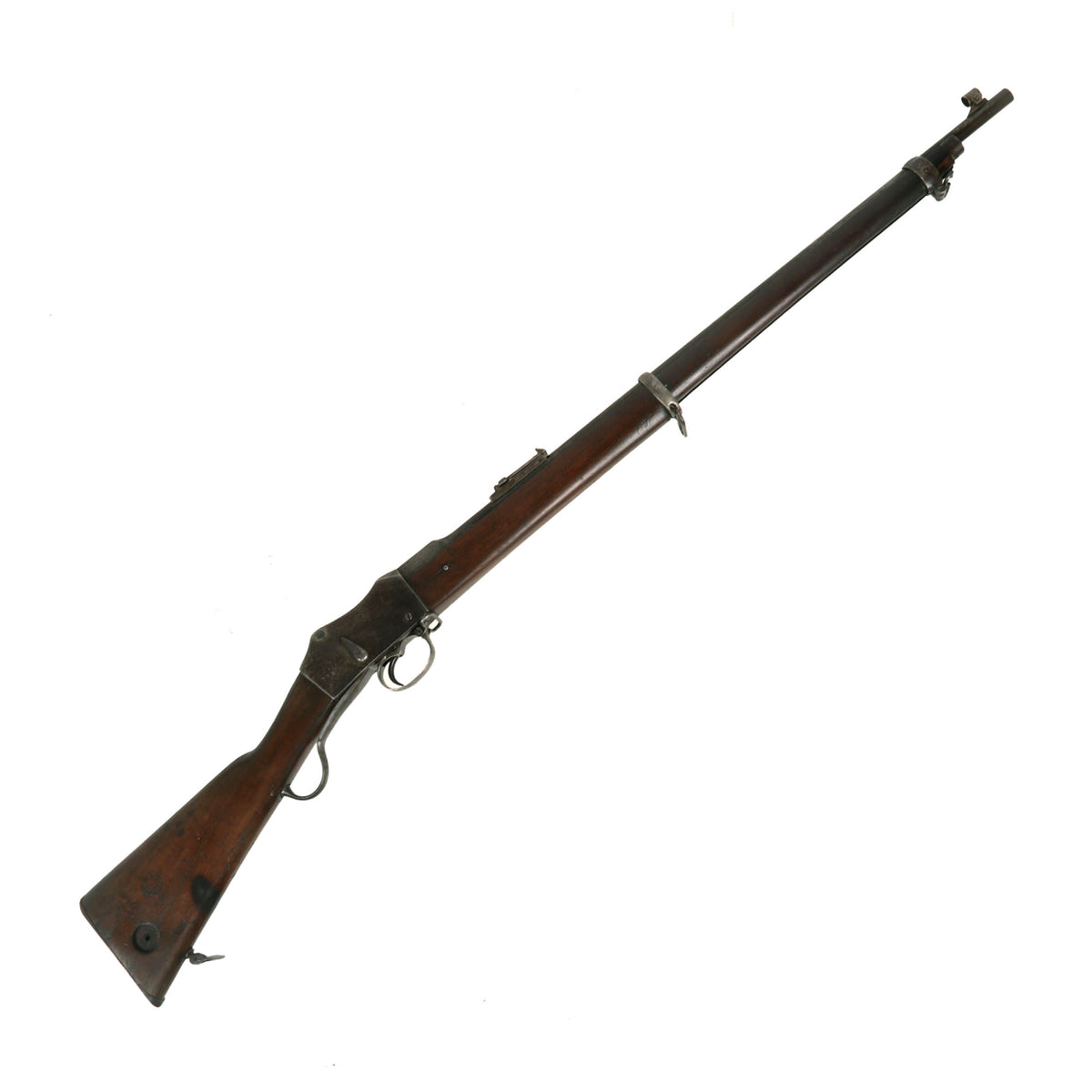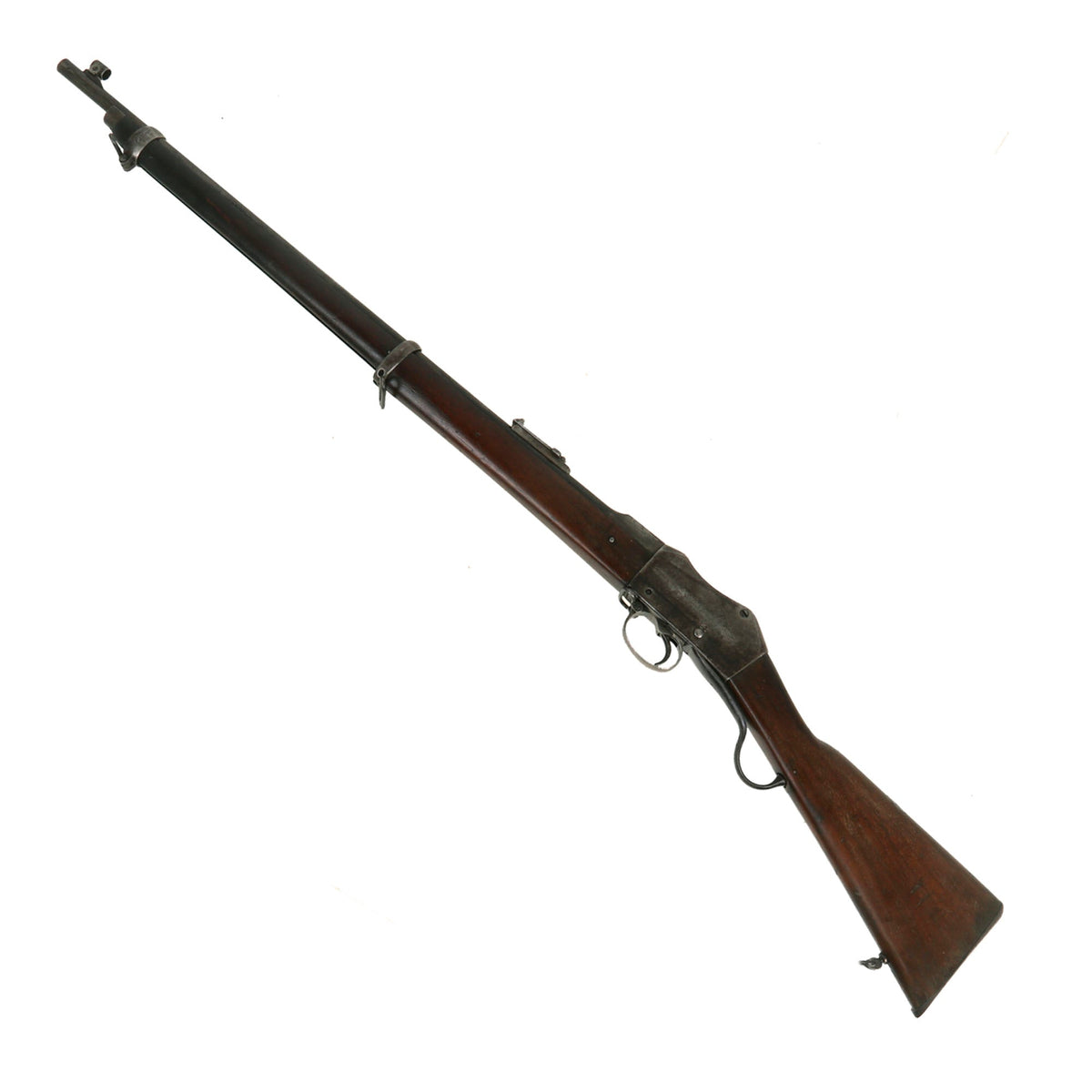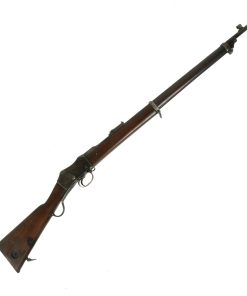Original British P-1871 Martini-Henry MkI/II Rifle Converted to .22 Rimfire Trainer by C.G. Bonehill – dated 1875 Original Items
$ 1.595,00 $ 398,75
Original Item: Only One Available. Well this is definitely something we have very seldom seen before: a Martini-Henry long rifle converted to .22 for training use! Usually we see .303 conversions, intended for service, but the platform was also good for converting rifles to use in training. This is one such example, and it was converted in Birmingham England by a well-known maker of the time, though we unfortunately do not know exactly when this conversion took place. Definitely some great research potential here!
Martini-Henry rifles, the original manufacturer information would be stamped onto the right side of the action, while the left side would have information regarding the conversion. This example is marked on the right action with original maker information, which is now somewhat faint, though the Royal cypher and “Mark of Arm” are still clear:
(Crown)
V.R.
B S A & M Co
1875.
(Lock Viewer Mark)
I I.
The left side is marked with the conversion information for the .22 conversion:
CONVERTED BY C.G. BONEHILL OF BIRMINGHAM
FOR THE SOCIETY OF MINIATURE RIFLE CLUBS
This rifle definitely has led an interesting life, and in fact was converted TWICE! It was originally made in 1875 (faintly marked) as a Martini-Henry Mk I rifle by Birmingham Small Arms & Metal Co., a large private company that was a major government contractor for decades. This early version featured a polished breech block, brass breech block axis pin, and other features that were later removed. As with almost all of the Mark I rifles in service, when the Mark II was introduced this rifle was converted to the Mk.II standard, indicated by how the “II.” is off center under the “Lock Viewer’s Mark”.
With the introduction of the Lee-Metford in 1888, all Martini-Henry rifles became obsolete, and were relegated to home use and colonial troops. As such this rifle was then later converted to .22 Rimfire for use in training, possibly for the military or maybe for cadet use. This was undertaken by Christopher G. Bonehill, an English gunmaker from Birmingham, England who began working in 1872 and continued into the early 20th century. He was quite well regarded, and eventually became a guardian of the Birmingham Proof House. The company installed a completely new barrel, which is also marked by the company, and indicates it is for AMMUNITION .22, along with British proofs. The stock has an ENFIELD marked rondel proof, so that was most likely swapped at at some point.
Overall the rifle definitely looks like a rifle that saw long service, with the finish faded to a peppery mottled patina overall. The action cycles correctly with a crisp dry fire, though we have not tested it for any ability to eject cartridges. We checked the bore, and there is faint rifling present, but it definitely saw much use after being converted to a training rifle. There is wear and some past oxidation and fouling present. The stocks are in very good condition, with a lovely color and patina of age. They show a bit of cracking and denting, as well as a repair to the butt stock toe.
A wonderful piece of British and Firearms history! An antique, already over 135 years old and ready to research and display!
The Martini action, adopted by the British in 1871 was one of the strongest ever developed and saw military service in England and the Empire, in one form or another for almost seventy years. The most famous action of course being the defense of Rorke’s Drift in Natal, South Africa in the 1879 Zulu War. They saw extensive use all over the British Empire.
Specifications-
Year of Manufacture: 1886 – later converted to .22lr
Caliber: .22lr
Cartridge Type: Rimfire Cartridge
Overall Length: 30 Inches
Overall Length: 45 3/4 Inches
Action type: Falling-Block
Feed System: Single Shot
Fast Shipping with Professional Packaging
Thanks to our longstanding association with UPS FedEx DHL, and other major international carriers, we are able to provide a range of shipping options. Our warehouse staff is expertly trained and will wrap your products according to our exact and precise specifications. Prior to shipping, your goods will be thoroughly examined and securely secured. We ship to thousands clients each day across multiple countries. This shows how we're dedicated to be the largest retailer on the internet. Warehouses and distribution centres can be located throughout Europe as well as the USA.
Note: Orders with more than one item will be assigned a processing date depending on the item.
Before shipping before shipping, we'll conduct a thorough inspection of the items you have ordered. Today, the majority of orders will be delivered within 48 hours. The delivery time will be between 3-7 days.
Returns
The stock is dynamic and we cannot completely manage it because multiple stakeholders are involved, including our factory and warehouse. So the actual stock may alter at any time. It's possible that you may not receive your order once the order has been made.
Our policy is valid for a period of 30 days. If you don't receive the product within 30 days, we are not able to issue a refund or an exchange.
You can only return an item if it is unused and in the same state as the day you received it. You must have the item in its original packaging.
Related products
Uncategorized
Band of Brothers ORIGINAL GERMAN WWII Le. F.H. 18 10.5cm ARTILLERY PIECE Original Items
Uncategorized
Uncategorized
Uncategorized
Uncategorized
Uncategorized
Armoured Fighting Vehicles of the World: AFVs of World War One (Hardcover Book) New Made Items
Uncategorized
Uncategorized
Uncategorized
Uncategorized
Uncategorized
Australian WWII Owen MK1 Machine Carbine SMG Custom Fabricated Replica with Sling Original Items
Uncategorized
Uncategorized
Uncategorized
Uncategorized
Armored Burgonet Helmet & Polearm from Scottish Castle Leith Hall Circa 1700 Original Items
Uncategorized
Angolan Rebel 1970s era 60mm Inert Display Mortar from Angolan Civil War Original Items












































































